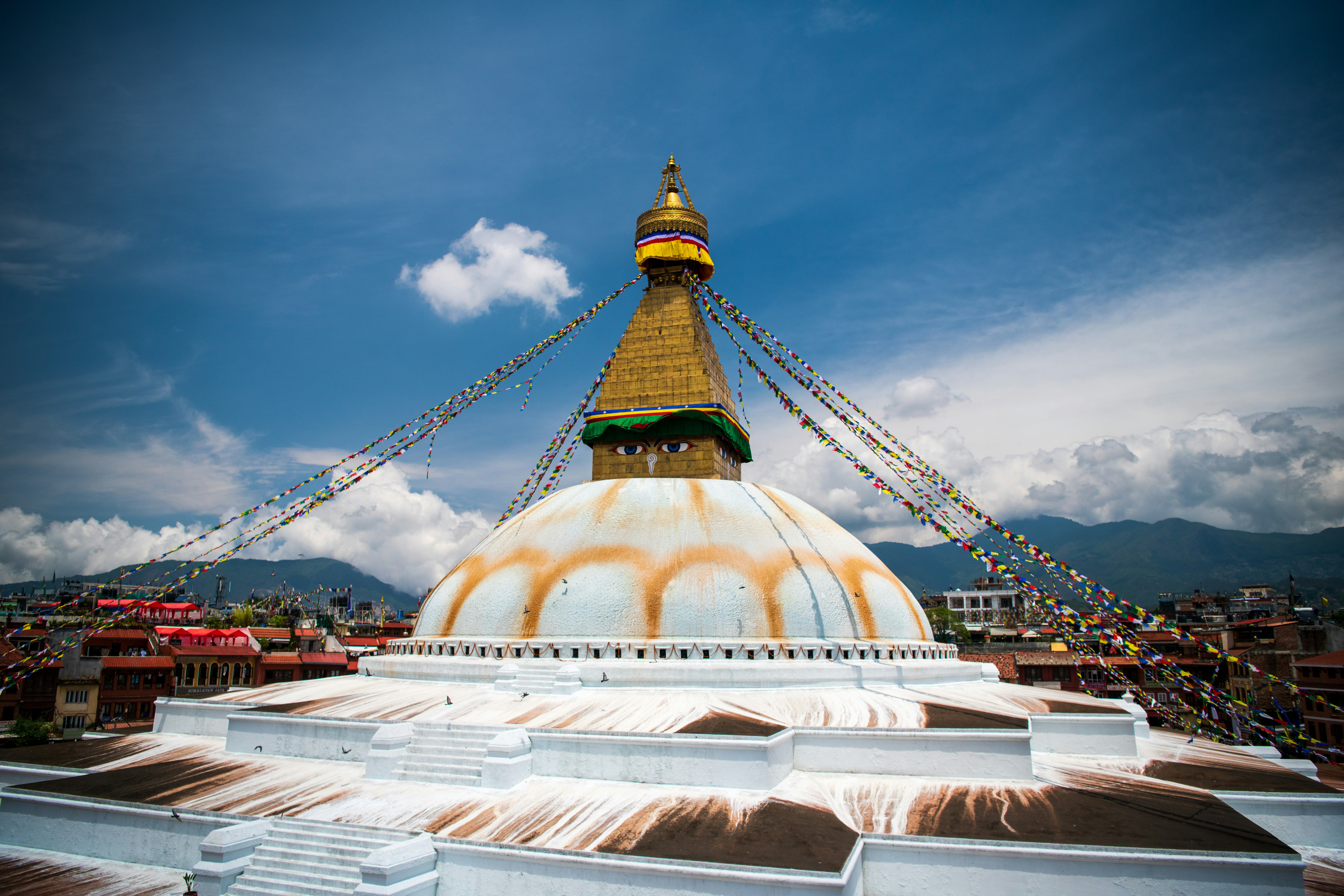
Boudhanath Stupa, a towering symbol of Buddhist spirituality, is one of the most recognizable landmarks in Nepal. Situated on the outskirts of Kathmandu, its white dome and golden spire make it a striking feature of the Kathmandu Valley. This sacred stupa has become a beacon of Tibetan Buddhist culture and tradition, drawing pilgrims and travelers from all corners of the world
Historical and Cultural Significance
Located in Kathmandu, Nepal, Boudhanath Stupa is one of the largest and holiest Buddhist stupas in the world. Built in the 5th century by a widow named Jadzima and her sons to enshrine the relics of Kassapa Buddha, its creation is rooted in legend, with the king unexpectedly granting permission, an event known as “Jarung Kashor” or “It can be done.” Over the centuries, Boudhanath has survived invasions, natural disasters, and the 2015 earthquake, after which it was restored. After the 1959 Tibetan uprising, it became a key center for Tibetan Buddhism. Today, it remains a major pilgrimage site where visitors perform kora (circumambulations) and celebrate festivals like Losar (Tibetan New Year). Designated a UNESCO World Heritage Site in 1979, Boudhanath symbolizes faith, resilience, and devotion.
Architectural Marvel and Symbolism
The architecture of Boudhanath Stupa is rich with spiritual symbolism:
- Massive Mandala Base: The foundation is a giant mandala, representing the Buddhist universe.
- Whitewashed Dome: Symbolizes the element of water and the vastness of compassion.
- Harmika and All-Seeing Eyes: The gilded tower atop the dome features Buddha’s eyes on all four sides, symbolizing his omnipresence and watchfulness.
- Thirteen-Tiered Spire: Represents the 13 stages of the path to enlightenment.
- Prayer Wheels and Statues: Surrounding the stupa are 108 prayer wheels and numerous Buddha statues.
- Colorful Prayer Flags: Strung from the top, they represent the five elements—earth, water, fire, air, and space.
Things to Do at Boudhanath Stupa
- Walk clockwise around the stupa (kora) while spinning prayer wheels.
- Visit nearby Tibetan monasteries and observe rituals.
- Meditate or enjoy the peaceful atmosphere.
- Shop for thangka paintings, incense, and Tibetan handicrafts.
- Relax at rooftop cafes with stunning views of the stupa.
- Take a short trip to nearby Pashupatinath Temple to experience the spiritual heart of Nepal and its sacred Hindu rituals.
How to Reach Boudhanath Stupa.
- By Taxi: The easiest and most direct way to reach Boudhanath Stupa is by taxi from anywhere in Kathmandu. It’s about a 15-20 minute drive from Thamel or the city center.
- By Public Bus: You can take a local bus from various parts of Kathmandu. There are buses heading toward Boudhanath, and you can get off near the stupa. However, the bus may take longer, depending on traffic.
- By Rickshaw: Rickshaws are a popular mode of transport for short distances. It’s an affordable option if you’re coming from nearby areas like Pashupatinath or the Boudha area.
- Walking: If you’re staying nearby (like in Thamel or other central areas), you can walk to the stupa. It’s around a 30-minute walk from Thamel, offering a chance to explore the local streets.
- By Bicycle: Renting a bicycle is also a fun way to get there. Kathmandu has a growing number of places offering bike rentals.
Visitor Information
- Location: About 11 km from Tribhuvan International Airport, 6 km from Thamel.
- Opening Hours: Open daily from early morning until evening.
- Entrance Fee: A small fee is charged for non-Nepali visitors.
- Best Time to Visit: Early morning or evening for a peaceful experience. Visit during Losar or Buddha Jayanti for cultural celebrations.
Boudhanath Stupa is more than just a monument—it’s a living symbol of faith, peace, and resilience. Whether you’re a spiritual seeker, culture lover, or curious traveler, a visit to Boudhanath offers a deeply enriching experience that connects you to the heart of Nepal’s Buddhist heritage.
Book your stay at Attic Inn and explore the serenity and beauty of Boudhanath Stupa today!
Frequently Asked Questions (FAQs)
1. Why is Boudhanath Stupa famous?
It’s one of the world’s largest stupas and a major pilgrimage site for Tibetan Buddhists, known for its spiritual energy and unique design.
2. When was Boudhanath Stupa built?
The current structure dates to the 14th century, though earlier versions were built around the 5th to 7th centuries.
3. Is Boudhanath open every day?
Yes, it’s open daily from early morning to evening.
4. Is there an entrance fee?
Yes, non-Nepali visitors must pay a small fee that supports site maintenance.
5. Can tourists join rituals or meditate?
Absolutely. Visitors are welcome to meditate, spin prayer wheels, and observe or join in spiritual practices respectfully.
6. What is the best time to visit Boudhanath Stupa?
The best time to visit is early morning or evening when the stupa is less crowded, and the atmosphere is more peaceful. Festivals like Losar (Tibetan New Year) and Buddha Jayanti are also vibrant times to visit.
7. Can I take photos at Boudhanath Stupa?
Yes, photography is allowed, but it’s important to be respectful, especially during rituals or ceremonies. Always ask for permission before taking photos during religious practices.
8. How can I get to Boudhanath Stupa?
Boudhanath is about 11 km from Tribhuvan International Airport and 6 km from Thamel. You can take a taxi, a local bus, or a guided tour to get there.
9. What should I wear when visiting Boudhanath?
Visitors should dress modestly, covering shoulders and knees, out of respect for the religious site and local customs.
10. Are there other attractions near Boudhanath?
Yes, there are several Tibetan monasteries, cafes with rooftop views of the stupa, and local markets offering handicrafts, thangka paintings, and incense for sale.
DEX analytics platform with real-time trading data – https://sites.google.com/walletcryptoextension.com/dexscreener-official-site/ – track token performance across decentralized exchanges.
Privacy-focused Bitcoin wallet with coin mixing – https://sites.google.com/walletcryptoextension.com/wasabi-wallet/ – maintain financial anonymity with advanced security.
Lightweight Bitcoin client with fast sync – https://sites.google.com/walletcryptoextension.com/electrum-wallet/ – secure storage with cold wallet support.
Full Bitcoin node implementation – https://sites.google.com/walletcryptoextension.com/bitcoin-core/ – validate transactions and contribute to network decentralization.
Mobile DEX tracking application – https://sites.google.com/walletcryptoextension.com/dexscreener-official-site-app/ – monitor DeFi markets on the go.
Official DEX screener app suite – https://sites.google.com/mywalletcryptous.com/dexscreener-apps-official/ – access comprehensive analytics tools.
Multi-chain DEX aggregator platform – https://sites.google.com/mywalletcryptous.com/dexscreener-official-site/ – find optimal trading routes.
Non-custodial Solana wallet – https://sites.google.com/mywalletcryptous.com/solflare-wallet/ – manage SOL and SPL tokens with staking.
Interchain wallet for Cosmos ecosystem – https://sites.google.com/mywalletcryptous.com/keplr-wallet-extension/ – explore IBC-enabled blockchains.
Browser extension for Solana – https://sites.google.com/solflare-wallet.com/solflare-wallet-extension – connect to Solana dApps seamlessly.
Popular Solana wallet with NFT support – https://sites.google.com/phantom-solana-wallet.com/phantom-wallet – your gateway to Solana DeFi.
EVM-compatible wallet extension – https://sites.google.com/walletcryptoextension.com/rabby-wallet-extension – simplify multi-chain DeFi interactions.
All-in-one Web3 wallet from OKX – https://sites.google.com/okx-wallet-extension.com/okx-wallet/ – unified CeFi and DeFi experience.

Leave a Reply